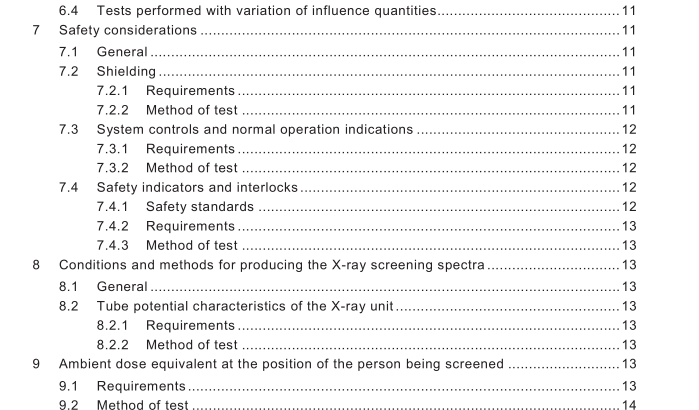BS IEC 62463:2010 pdf download – Radiation protection instrumentation – X-ray systems for the screening of persons for security and the carrying of illicit items
6.2 Reference conditions and standard test conditions Reference and standard test conditions are given in Table 1 . Reference conditions are those conditions to which the performance of the instrument is referred and standard test conditions indicate the necessary tolerances in practical testing. Except where otherwise specified, the tests in this standard shall be performed under the standard test conditions given in the third column of Table 1 .
6.3 Tests performed under standard test conditions Tests performed under standard test conditions are listed in Table 2, which indicates, for each characteristic under test, requirements according to the subclause where the corresponding test method is described.
6.4 Tests performed with variation of influence quantities For those tests intended to determine the effects of variations in the influence quantities given in Table 3, all other influence quantities shall be maintained within the limits for the standard test conditions given in Table 1 unless otherwise specified in the test procedure concerned. 7 Safety considerations 7.1 General The manufacturer shall provide a description of the radiation safety systems that are designed to prevent, during normal operation of the X-ray screening system, accidental exposure to the operator and public and for ensuring that the person being screened is not exposed above manufacturers stated maximum dose per screening procedure (see Clause 9). The accompanying manual provided by the manufacturer shall include details of the fail-safe features of the radiation safety exposure circuit. These details shall also include functional test instructions. The manufacturer shall reference the radiological and electrical safety considerations used for the system by quoting applicable IEC and ISO publications, see 7.4.1 .
7.2 Shielding
7.2.1 Requirements When a person is being screened and the X-ray beam is emanating, shutter or beam stop open, the ambient dose equivalent rate to any area where other members of the public or the operator have access should not exceed 2,5 μSv⋅h –1 taken over several scans. Where the doserate could exceed this value at a distance in excess of 30 cm from any external surface the manufacturer shall provide an isodose contour at this value. National regulations may stipulate lower limits.
7.2.2 Method of test The direction in which the highest dose per screening procedure is emitted shall be identified by measurement. (Technical drawings and further physical aspects may assist in determining this but should not be relied upon.) Careful consideration should be given to control stations, fissures around doors, ventilation openings, shielding joints and any other vulnerable areas based on technical drawings. If there are outer doors or removable panels that are not locked or interlocked, the radiation survey shall be repeated with the doors open and panels removed. At the distance specified in 7.2.1 , from the surface of the device the ambient dose equivalent per screening procedure (that means the sum of all scans necessary to examine a person) shall be measured. The X-ray scanner shall be operated in the mode with the greatest high voltage, greatest tube current and the smallest total filtration allowed to be used in operation. This shall be done for at least five subsequent screening procedures following each other as fast as the device is able to perform. The total dose over all these screening procedures shall be divided by the time all these screening procedures took. This value plus the overall uncertainty (k = 2) shall not exceed the ambient dose equivalent rate requirement listed in 7.2.1 . This dose equivalent rate shall be determined by a reference instrument having a response that is within 20 % of the true value over the energy range from 25 keV to the maximum energy in keV corresponding to the maximum operating voltage of the X-ray tube.
7.3 System controls and normal operation indications
7.3.1 Requirements The operating conditions, namely the tube voltage and tube current, for each mode of operation shall be pre-set by the manufacturer and shall not be alterable by the system operator. If there is more than one mode, prior to each scan a mode indicator shall be clearly visible to the operator.
